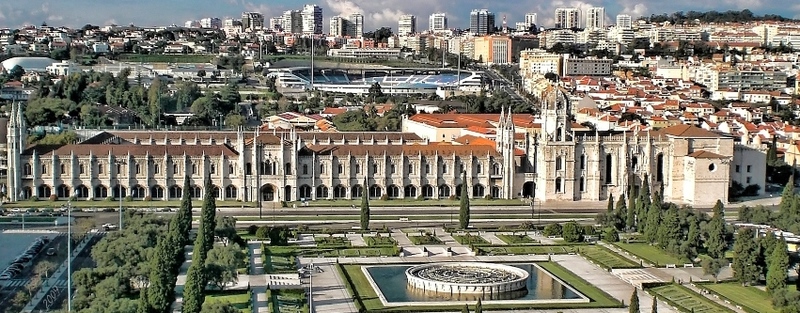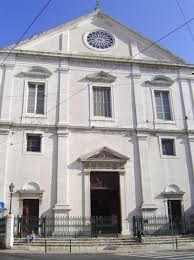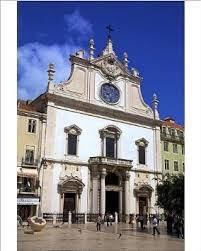

Sao Roque church, exterior
The Altis had a nice rooftop restaurant, Rossio, so we started the day with a substantial breakfast on the sunny upper deck overlooking the city. Then we grabbed our daypacks and headed out to see “the church with the plainest façade, but with one of the city’s richest interiors”—Igreja de São Roque. The bland, whitewashed exterior was indeed a dichotomy to the exquisite, richly decorated interior. Built in the sixteenth century, it has eight chapels, each a masterpiece of Baroque art, but the most notable is the eighteenth-century chapel of St. John the Baptist, considered the “world’s most expensive chapel.” It was designed and constructed in Rome using the most costly materials available: ivory, agate, lapis, gold, silver, and porphyry, then blessed by the Pope before it shipped, in 1747, to Lisbon. Amazingly, it survived the earthquake of 1755 virtually unscathed. Adjoining the church is the Museum of Sacred Art. It houses an impressive collection of baroque silver, and a pair of elaborately decorated bronze-and-silver torch holders.

Sao Roque interior, the altar of St. John the Baptist
Igreja de São Roque was built as a shrine to house a relic of Saint Rocco, who was canonized for healing plague victims. His feast is commemorated on August 16th. Rocco was born into nobility around 1340 A.D. in Montpellier, France. At birth, his parents noticed a red, cross-shaped birthmark on his chest, and at a young age he showed a deep devotion to God. Early in his young life, his parents died and left him under the care of his rich uncle, the Duke of Montpellier. In adulthood, Rocco distributed his wealth among the poor, took a vow of poverty, and left France for Rome, where he cured many from the dreaded black plague, which was rampant in Italy. Eventually, he too contracted the disease and was banished from the city. He found refuge in a cave on the outskirts of town. Miraculously, a dog befriended him and brought him scraps from a nearby castle. One day, the lord of the castle followed the dog and discovered Rocco. The lord took him home and cared for him, but Rocco never truly regained his strength. He spent three more years traveling in Italy, until he returned to France. Weak and sickly in appearance, his fellow townspeople did not recognize him and suspected him of spying. They threw him in jail where he remained for five years. On August 16, 1378, a guard reported that Rocco was near death, and his crumpled body was radiating a blue light. The governor demanded to know Rocco’s true identity. “I am your nephew,” he said. In disbelief, the uncle had Rocco disrobed. The moment he saw the red cross-like mark on his nephew’s chest he knew the truth, but by then Rocco had left this life. Saint Rocco is venerated by the Roman Catholic Church as the protector against contagious diseases, and he is the patron saint of dogs. He is symbolized as a pilgrim with a dog at his side, and often the dog is licking a wound on the saint’s leg. His body is entombed in glass at the church of San Rocco in Venice, Italy.

St. Rocco, patron saint of dogs and the plague
We left the church and caught the metro to Belém. We wished we had had the time during our stay at the Altis Belém to have toured the Jerónimos Monastery, but time didn’t permit, so now we were on our way back to the town. The monastery was a stunning work of art, a grand structure that exuded wealth and power, and for a religious order that embraced the Rule of St. Augustine, I wondered how the monks concentrated on prayers when surrounded by such ornateness.
Built in 1502, during the Age of Discovery, to commemorate Vasco de Gama’s successful voyage to India, the style of the monastery is Manueline architecture, the same style as the Belém Tower, which is located nearby. The architectural style is unique to Portugal, and is a combination of Flamboyant Gothic, Moorish, and early Renaissance influences. It is characterized by an elaborate use of sculptural detail, most are maritime motifs, stone carvings of coils of rope, sea monsters, coral, and the like, depicting the world exploration at sea. Construction was funded by treasures from explorations in Africa, Asia, and South America, as well as stiff tariffs on the Portuguese-controlled spice trade. The architect was Diogo de Boitaca, a Frenchman, and the location was on the banks of the Tagus River.
Upon completion, the king invited the powerful Hieronymites, the order of Saint Jerome, to occupy the monastery. The hermit monks strictly adhered to the Rule of St. Augustine, a rule governed by chastity, poverty, obedience, solitude, labor, prayer, fasting and abstinence, care of the sick, and silence during meals. It helped that these monastic hermits also shared the king’s political views. The Hieronymites occupied Jerónimos for four hundred years, until the dissolution of the monasteries in 1833. During the 1755 earthquake, the monastery was damaged, but not destroyed, and after many restoration projects is now state property and open to the public. My only disappointment, as is the case with many historical sites, only a small portion of the buildings are available for public viewing. For such a colossal structure, I felt a bit cheated that we only saw the cloisters, the entrance to the former refectory, the church interior, and the courtyard garden. Side note: go early to avoid the mass descension of tourists.
We took the metro to within a few blocks of our hotel and ducked into the first outdoor cafe we spotted. We nursed espressos and snacked on pastéis de nata, Portuguese egg tart pastries sprinkled with cinnamon and powdered sugar. Recharged, we were ready to ride the funicular system. There are four but we only rode two, and technically one was actually an elevator, not a true funicular. The second oldest funicular is Ascensor da Gloria, also the most popular with tourists. It serves the Bairro Alto and Praca dos Restauradores, a historic square. The last one is Elavador de Santa Justa, also known as “Elevator of Carmo,” was first put in use in 1902. Its purpose is to move people up and down Carmo Hill, unless you want to climb the fifty-foot spiral staircase to be treated to a panoramic view of Lisbon. The elevator rises to a height of one-hundred-and-forty-seven feet. The designer, Raoul de Mesnier du Ponsard, was inspired by the architecture of the Eiffel Tower.

St. Dominic, Sao Domingos, the church between two buildings
Late afternoon, we boarded the Carmo elevator and descended the hill. Our destination was Igreja de São Domingos (Church of St. Dominic) for Saturday vigil mass. The church was dedicated in 1241 and was once the largest church in Lisbon. Although heavily damaged during the earthquakes of 1531 and 1755, then devastated by a fire in 1959 that destroyed most of the interior, the church has been restored, but still shows signs of the destructive fire. As we approached the entrance we weren’t sure we had the right location, because the structure was sandwiched between two buildings. However, the cross on the rooftop told us we were probably in the right place.
Not as richly appointed as Igreja de São Roque, St. Dominic had its own beauty. The main styles are Mannerism and Baroque. The chancel is black marble and dramatic, and the ceiling is a warm rose color, complimenting the black marble. As I made my way down the center aisle, a woman behind me gently touched my shoulder and whispered, “Watch your step.” A statement of that nature can mean just about anything to a thriller writer, and I was pondering her cryptic remark, she nodded to her right. I followed her gaze to the row of chairs sitting about a foot below the main aisle. She smiled. I wondered how many unsuspecting tourists had fallen into their seats rather than stepped down into them. I thanked her for saving me from a foolish mistake by returning her smile. When I attended mass I didn’t know about the earthquakes or the fire, so as I looked about I knew something wasn’t quite right, but couldn’t immediately detect what until I noticed cracks in the church columns and the missing facial features or body parts on some of the statues. It saddened me to see such destruction, but the spiritually moving mass was richer than any materialistic adornment in any church in the world.
That morning, at the recommendation of our concierge, we had made reservations at Sacramento do Chiado. Since we were dining much later than normal, we skipped the starters and passed on dessert, going straight for the mains and a good bottle of Portuguese white wine. We ordered paella, a dish my mother had mastered. Living close to the ocean most of my adolescence, I was raised on an abundance of fresh fish and shellfish, and I loved rice, a staple my Southern father never seemed to tire of, so as children we certainly ate our share. Marry the two, fish and rice, and you have paella. The dish at Sacramento was very good, but it’s tough to beat my mother’s rendition.


0 Comments